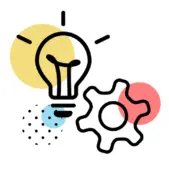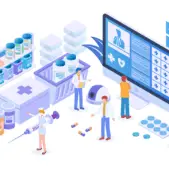Think of your website as the storefront or display window of your online business. While it’s a key component of your online presence, just having a storefront isn’t enough to drive meaningful conversions. In fact, in a highly competitive environment, a stale storefront can do your business more harm than good. To truly optimize conversion rates and maximize success, it may be time to redesign your website.
A website redesign involves more than just a fresh look. It encompasses the strategic overhaul of various elements such as page speed, navigation, responsive design, visual aesthetics, and search engine optimization (SEO). Through this process, you can address user experience pain points, improve engagement, and create a seamless journey to guide visitors toward desired actions.
In this article, we explore how a website redesign can enhance conversion rates. We’ll also provide insights into key strategies and best practices for a successful redesign process.
1. Increased Page Speed and Reduced Loading Times
Your website’s page speed can significantly impact its conversion rates. Quick-loading pages encourage visitors to stay longer and reduce bounce rates. In fact, one study found that conversion rates improve 17% for every second that the site loads faster.
What’s more, users view fast-loading sites as more trustworthy and reliable, which influences their decision to convert. Page load speed is also a key ranking factor for Google and Bing.

The importance of page speed has also increased with the rise of mobile browsing. A mobile-optimized website is no longer a nice-to-have; it’s a necessity to stay competitive. In general, a fast page load is considered less than 2 seconds on desktop and 1 second on mobile. But recent statistics show the average page load time is 2.5 seconds on desktop and a much-slower 8.6 seconds on mobile.
The stark difference may be because some websites aren’t optimized for mobile. Or they may be using a responsive design approach rather than a mobile-specific one. Regardless, it’s something to keep in mind during a website redesign. Users on the go have shorter attention spans and less tolerance for slow pages. Slow mobile speeds will lead them to abandon the site and turn to competitors.
Tips to Optimize Mobile Page Speed
When improving site speed, make sure it doesn’t negatively affect the user interface or experience. A website should be fast, interactive, and engaging to boost conversions and revenue. As you redesign your website with mobile performance in mind, consider these tips:
- Remove unnecessary characters, formatting, and comments from CSS, JavaScript, and HTML. This reduces data usage and boosts load times.
- Use a Content Delivery Network (CDN) to reduce server response times and latency.
- Optimize images by compressing them and using modern image formats like WebP.
- Apply Lazy Loading for images and videos to load them only when they enter the viewport and Infinite Scroll for content-heavy pages to load additional content as the user scrolls down.
- Implement accelerated mobile pages (AMP)—copies of current webpage content that use stripped-down HTML. They load instantly, providing a better user experience.
- Use tools like Google PageSpeed Insights and Lighthouse to analyze and monitor your website’s performance on an ongoing basis.
UpTop Perspective
Great UX is the engineering of the entire experience, not just the design of the screens.
2. Easier Navigation
Intuitive website navigation helps users find the information they need easily. A well-structured navigation enhances user experience and impacts search engine rankings, lead generation, brand perception, and conversions.
Designing website navigation isn’t a one-size-fits-all approach. It should cater to your specific customers through research, experiments, and testing. In your website redesign, focus on user preferences rather than personal or team preferences.
These proven best practices will help you streamline navigation for your users.
Reduce Top-Level Navigation Links to Seven
After the seventh item, readers tend to scan rather than read. Keep top-level options simple and choose the order of your menu items strategically.
To prioritize relevant options, conduct a card-sorting exercise with a few customers or representative audience. Give them labeled cards that represent pages or product categories on your website. Ask them to arrange the cards as they see fit and suggest category names.
UpTop takes this a step further. We provide a complimentary exercise called Tree Testing. After incorporating the insights from the card sort exercise, we test the new version of the information architecture (IA) with users.
Optimize Your Mobile Website’s Navigation
Simplify your mobile site navigation by separating shopping links from other content. This can improve user guidance, reduce distractions, and create a smoother experience. Also, ensure top-level mobile links direct users to shopping pages rather than non-shopping pages like “About Us” or “Articles.” By rearranging links, you can drive more traffic to important pages.

Replace complex drop-down menus as well. For complicated, unfamiliar, or extensive options in your drop-down menu, use a detailed page instead.
Optimize Frictionless Site Search
Online visitors who use a site’s search feature are 2-3 times more likely to convert (Forrestor Research). This is because search box users usually have purchasing or action intent and are more likely to find the desired information.
Create Separate Menus for Different Audiences
Designing an interface for two distinct groups can be challenging. But if, for instance, you cater to both wholesalers and retailers, divide your links into two. This ensures each group can find what they need without having to navigate irrelevant content.
Include a Comprehensive Footer
Navigational fatigue can occur on sites with complex hierarchies. Mega footers simplify navigation by providing links to all key pages, reducing the need to navigate through multiple sub-menus. Include a mega footer in your website redesign to improve a site’s bounce rate and conversion rate. Incorporating important keywords in the mega footer can also boost Google search rankings.
Remove Social Media Icons in the Header
Each link is a bright exit sign that leads visitors to numerous distractions. If they get distracted by social media, it may be hard to regain their attention. Placing these links in the footer is a more strategic choice.
3. Responsive Design
Responsive web design ensures websites are accessible and user-friendly across different devices. They adjust the layout and content based on the screen size and orientation of the device being used.
One way responsive web design achieves accessibility and user-friendliness is through a flexible grid system and proportion-based layout. This enables elements on the website to resize and reposition themselves appropriately to fit the screen size. As a result, content remains readable and easily navigable on desktop computers, tablets, and smartphones.
In addition, responsive design incorporates fluid images and media queries to ensure images and videos scale proportionally to the size of the screen. This prevents distortion or cropping and helps your site maintain visual appeal across different devices.
Transforming Your Static Site
There are plenty of reasons to prioritize a responsive website in your redesign. A website that’s accessible and user-friendly on all devices is more likely to engage users and keep them on the site longer. When users have a positive browsing experience, they’re more inclined to explore the content, interact with calls to action, and convert.
What’s more, responsive design can improve SEO performance, as search engines like Google prioritize mobile-friendly websites in search results. This increased visibility can drive more traffic to the website, potentially leading to higher conversion rates.
Upgrading your static site to a responsive design will not only save time but also improve data tracking and analytics. While choosing a framework, converting code, and testing on multiple devices are essential for creating a responsive website, it is also crucial to plan your design, use responsive typography, ensure accessible design, and continuously optimize performance through resource minimization and user feedback. These additional steps ensure a comprehensive approach to building a truly responsive and high-quality website.

4. Visually and Aesthetically Pleasing UI
When a website is visually appealing, it not only captures the user’s attention. It also creates a positive first impression, which can lead to increased trust and credibility.
Aesthetically pleasing design elements such as high-quality images, harmonious color schemes, and clean typography can evoke positive emotions in users. This makes them more likely to spend time on the site and engage with the content. Such an emotional connection can foster a sense of trust and loyalty, leading to higher conversion rates.
Micro-interactions can also play a crucial role in improving design and user experience. Think, subtle animations or feedback mechanisms that occur in response to user actions. These small, interactive elements make the website more engaging and interactive and provide feedback to users. Basically, they guide users through the site and inform them of their actions.
For example, when users hover over a button, a simple animation can draw attention to a call to action. This will prompt users to click and potentially convert.
What’s more, micro-interactions can enhance usability by providing visual cues and feedback. For instance, a loading animation can reassure users that their action has been registered, reducing uncertainty and frustration.
UpTop Perspective
Consistent use of brand and UI elements in a design system across the customer journey (including web, mobile apps, and social), are critical to establishing trust and credibility with your customers.
5. Optimized for SEO with Humans in Mind
SEO is the practice of enhancing a website’s content to boost its visibility and ranking in organic search results. In your website redesign, keep in mind that the techniques employed to improve organic search performance can also enhance the user experience. These include:
- Relevant site content
- Efficient, clear site navigation
- Internal links between your content
- Heading tags and keyword use
- Alt tags for images
- Using keywords in URLs
- Enhancing page speed
Some practices are specifically for search engines as opposed to the user. Examples of practices that are labeled as “Technical SEO” include:
- Robots.txt file
- XML sitemaps
- Avoiding duplicate content
- Avoiding multiple redirects
- Using correct canonical tags
The combination of SEO for search engines and human users creates a synergistic effect that benefits both visibility and user engagement. When a website is optimized for search engines and provides a positive user experience, it attracts more organic traffic and encourages visitors to interact with the content. In addition, search engines like Google prioritize websites that offer valuable content and a seamless user experience.
By striking a balance between technical SEO optimizations and user-centered design elements, websites can attract more visitors. They’ll also provide a valuable browsing experience and achieve higher conversion rates.
Best Practices for Conversion Rate Optimization
Conversion rate optimization (CRO) aims to increase the number of website visitors who complete a specific action, like buy a product or submit a form. Before undertaking a website redesign, it’s essential to clearly define your goals and determine how you’ll track progress.

To identify friction points and opportunities for improvement, conduct a thorough analysis of your website’s user flow. Use the following methods to identify areas where users may encounter difficulties or experience friction. Look for high bounce rates, abandoned carts, or pages with low engagement to pinpoint potential issues.
Heat Mapping and Session Recording
Heat mapping tools visualize user interactions by showing where users click, scroll, or hover on a website. This helps identify hotspots, areas of interest, or areas that are being ignored.
Session recording tools capture actual user behavior. You can watch recordings of individual user sessions to understand how they navigate and interact with your site.
Journey Mapping
Journey maps visualize the end-to-end experience of a user trying to accomplish a specific goal on your website. Mapping out the user’s journey helps you understand their pain points, emotions, and areas where optimization can make a significant impact.
Personas
Personas are fictional representations of your target audience, based on demographics, behaviors, and motivations. Developing personas helps you design and optimize your website to cater specifically to the needs and preferences of your target audience.
Surveys and Customer Interviews
Surveys can help you identify areas for improvement, understand customer expectations, and gather quantitative data to complement qualitative research. But the process doesn’t end once you’ve gathered data, insights, and feedback and made the appropriate changes. CRO is an ongoing process. Continuous testing and analysis are key to achieving optimal results.
A/B Testing
A/B testing compares two versions of a web page or element to identify the better-performing option. Test different variations of elements such as headlines, calls to action, color schemes, or layouts to see which one leads to higher conversion rates.
Tracking and Analytics
Utilize web analytics tools like Google Analytics to track user behavior, traffic sources, conversion rates, and other metrics on an ongoing basis. Analyze data to uncover patterns, identify bottlenecks, and gain insights into changing user preferences and behaviors.
Website Redesign for Long-term Success
A website redesign can address usability issues, streamline navigation, enhance visual appeal, and optimize conversion funnels. But to do it well, you must analyze user behavior, identify pain points, and implement effective design and functionality changes.
A well-executed redesign ensures the website aligns with current industry standards, user expectations, and emerging trends. As a result, you’ll see improved engagement, increased trust, and higher conversion rates. It’s an investment that can significantly impact your business’s online success and growth.
At UpTop, our UX strategy, product design, and software development teams help businesses seize market opportunities and improve conversions by facilitating the creation of exceptional digital experiences. Our experts collaborate with you on UX strategy to provide direction for design decisions, then utilize in-depth research to validate those decisions.
Craft digital experiences that resonate with your customers while aligning UX with your business goals. Let’s connect.


